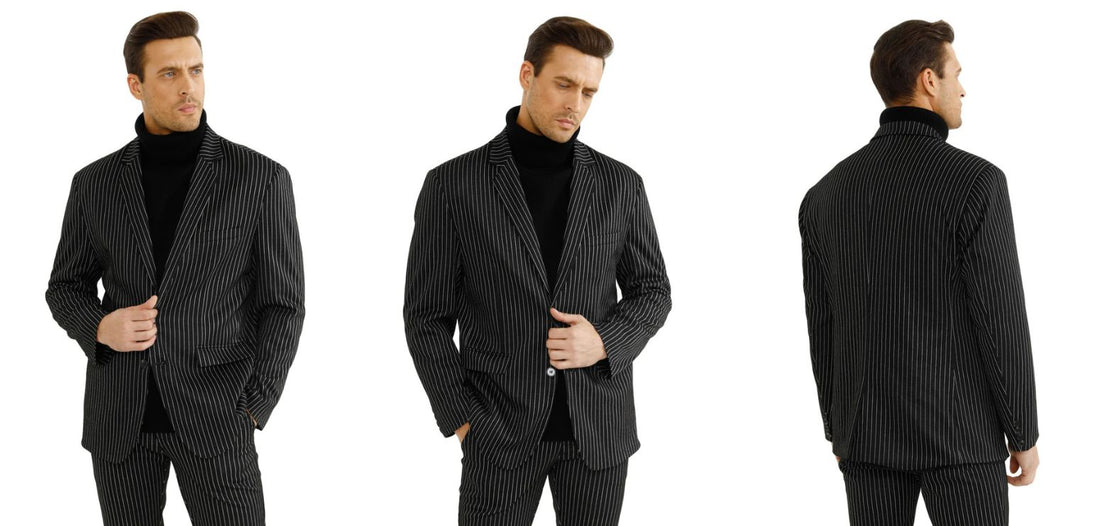
Was soll ich zu einem Vorstellungsgespräch anziehen?
Aktie
Bei der Vorbereitung auf ein Vorstellungsgespräch spielt Ihr Outfit eine entscheidende Rolle für einen positiven ersten Eindruck.
Es geht nicht nur darum, gut auszusehen; es geht darum, dem Arbeitgeber zu signalisieren, dass Sie es ernst meinen, professionell sind und die Chance respektieren.
Doch bei so vielen Optionen kann es schwierig sein, zu wissen, was angemessen ist. Sollten Sie einen Anzug tragen? Oder reicht Business Casual?

Warum die richtige Kleidung für ein Vorstellungsgespräch wichtig ist
Ihre Kleidung sagt viel über Ihre Persönlichkeit, Ihre Arbeitsmoral und Ihre Fähigkeit aus, sich an die Unternehmenskultur anzupassen.
Personalchefs fällen vorschnelle Urteile auf Grundlage Ihres Erscheinungsbildes, oft noch bevor Sie überhaupt sprechen.
In manchen Fällen kann Ihre Kleidung den Ausschlag geben zwischen Ihnen und einem anderen Bewerber mit ähnlichen Qualifikationen.
Durch gute Kleidung zeigen Sie, dass Sie vorbereitet, respektvoll und in der Lage sind, das Unternehmen zu repräsentieren.
Es geht um Selbstvertrauen – wenn Sie gut aussehen, fühlen Sie sich gut und dieses Selbstvertrauen wird in Ihren Antworten und Ihrer Körpersprache zum Ausdruck kommen.
1. Business Formal: Der klassische Anzug
Bei einem formellen Vorstellungsgespräch können Sie mit einem gut geschnittenen Anzug nichts falsch machen. Ein marineblauer, anthrazitfarbener oder schwarzer Anzug ist eine sichere Wahl. Diese Farben strahlen Professionalität und Autorität aus.
-
Die Passform ist entscheidend : Achten Sie darauf, dass der Anzug gut sitzt. Er sollte weder zu eng noch zu locker sein. Eine maßgeschneiderte Passform betont Ihre Silhouette und zeigt Liebe zum Detail.
-
Stoff : Wolle ist ein klassischer Stoff, da sie atmungsaktiv und strapazierfähig ist und in den meisten Klimazonen funktioniert.
-
Hemd und Krawatte : Ein frisches weißes oder hellblaues Oberhemd passt perfekt zu einem Anzug. Wählen Sie eine Krawatte mit dezentem Muster (nichts zu Auffälliges oder Auffälliges), da dies einen Hauch von Persönlichkeit verleiht und gleichzeitig Professionalität bewahrt.
2. Business Casual: Blazer und Slacks
Wenn Sie ein Vorstellungsgespräch in einem lockeren Business-Umfeld führen, können Sie sich für einen Blazer mit Anzughosen oder Chinos entscheiden. Dieser Look ist vielseitig und sieht dennoch professionell aus, ohne steif zu wirken.
-
Blazer : Entscheiden Sie sich für einen gut sitzenden Blazer in neutralen Farben wie Marineblau oder Grau. Wenn Sie abenteuerlustig sind, könnte ein Tweed- oder gemusterter Blazer funktionieren, aber achten Sie darauf, dass er dennoch dezent ist.
-
Hemd : Ein Button-Down-Hemd ist hier die beste Wahl. Vermeiden Sie auffällige Muster und entscheiden Sie sich für einfarbige Farben wie Hellblau oder Weiß. Poloshirts können in manchen Business-Casual-Situationen ebenfalls funktionieren, sie sollten jedoch sauber, tailliert und knitterfrei sein.
-
Hosen : Chinos in neutralen Farben (wie Beige, Marineblau oder Grau) eignen sich gut für Vorstellungsgespräche im Business-Casual-Stil. Achten Sie darauf, dass die Hose gut sitzt und richtig gesäumt ist. Vermeiden Sie alles, was zu eng oder zu weit ist.
3. Lässig: Elegant und sauber
Bei einem lockeren Vorstellungsgespräch sollten Sie gepflegt, aber nicht overdressed wirken. Eine schicke, gut sitzende Jeans oder Chinos mit einem sauberen, gebügelten Hemd reichen oft aus.
-
Jeans : Wenn die Unternehmenskultur entspannter ist und Jeans erlaubt, wählen Sie dunkel gewaschene Jeans ohne Abnutzungserscheinungen oder Ausbleichungen. Vermeiden Sie zerrissene oder zu legere Jeans.
-
Hemd : Mit einem Hemd mit Kragen, egal ob zum Zuknöpfen oder als gut sitzendes Polohemd, sind Sie auf der sicheren Seite. Für einen etwas entspannteren Look können Sie auch einen Strickpullover oder ein gut sitzendes Henley-Shirt in Betracht ziehen.
-
Schuhe : Turnschuhe können in manchen Fällen akzeptabel sein, aber saubere, polierte Halbschuhe, Stiefel oder Abendschuhe sind oft die bessere Wahl. Achten Sie immer darauf, dass Ihre Schuhe in gutem Zustand sind.
Allgemeine Tipps zur Kleidung für ein Vorstellungsgespräch
Halten Sie es sauber und ordentlich
Unabhängig von der Tätigkeit sollte Ihre Kleidung immer sauber, gebügelt und in gutem Zustand sein.
Zerknitterte Hemden, abgewetzte Schuhe oder Kleidung mit Flecken können den Eindruck vermitteln, dass Ihnen die Vorbereitung nicht wichtig genug ist.
Achten Sie auf die kleinen Details: Reinigen Sie Ihre Schuhe, schneiden Sie Ihre Nägel und achten Sie darauf, dass Ihre Kleidung richtig sitzt.
Vermeiden Sie zu legere Kleidung
Auch wenn in der Firma eine lockere Kleiderordnung gilt, sollten Sie es vermeiden, in zu legerer Kleidung wie Jogginghosen, T-Shirts mit Aufdruck oder Turnschuhen zu erscheinen.
Sie können sich jederzeit an die Unternehmenskultur anpassen, aber bei den meisten Vorstellungsgesprächen ist es besser, etwas overdressed als underdressed zu sein.
Achten Sie auf die Passform
Ein gut sitzendes Outfit wirkt professioneller und eleganter. Zu enge oder zu lockere Kleidung kann von Ihrem Erscheinungsbild ablenken und den falschen Eindruck vermitteln.
Männer sollten sich für einen Anzug oder ein Hemd entscheiden, das bequem an Schultern, Taille und Brust sitzt.
Die Hose sollte sauber über Ihre Schuhe abschließen und für Ihre Körpergröße die richtige Länge haben.
Vermeiden Sie häufige Fehler bei der Kleidung für Vorstellungsgespräche
1. Zu schick oder zu leger gekleidet
Der Schlüssel zu einem gelungenen Auftritt im Vorstellungsgespräch ist, die richtige Balance zu finden. Vermeiden Sie es, in einem lockeren Umfeld zu formell zu erscheinen, da Sie sonst den Eindruck erwecken können, nicht mit der Unternehmenskultur im Einklang zu sein.
Ebenso kann es den Eindruck erwecken, dass Sie unvorbereitet oder desinteressiert wirken, wenn Sie sich in einem formellen Umfeld zu leger kleiden.
2. Ablenkende Kleidung tragen
Vermeiden Sie auffällige Muster, übermäßigen Schmuck oder alles, was den Interviewer von Ihren Qualifikationen ablenken könnte.
Bleiben Sie bei einfachen, klaren Linien und Farben, die Ihren Look ergänzen, ohne aufdringlich zu sein.
Abschluss
Bei der angemessenen Kleidung für ein Vorstellungsgespräch geht es um mehr als nur die Wahl der richtigen Kleidung – es geht darum, Respekt für die Gelegenheit und das Unternehmen zu zeigen.
Im Zweifelsfall ist es besser, etwas overdressed als underdressed zu sein. Bleiben Sie immer auf der Seite der Professionalität und Sie werden sicher einen positiven Eindruck machen.
Denken Sie daran: Selbstvertrauen erwächst aus einer guten Vorbereitung, und die richtige Kleidung spielt dabei eine große Rolle.
